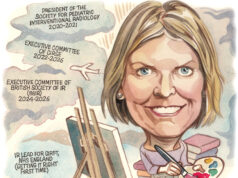
The Royal College of Radiologists (RCR) has welcomed the Getting It Right First Time (GIRFT) report into imaging services in England, released 10 November. One of the key recommendations of the report is for radiology departments to have dedicated provision of interventional radiology (IR) facilities.
The GIRFT radiology team, led by consultant radiologist Katharine ‘Kath’ Halliday (Nottingham University Hospitals NHS Trust, Nottingham, UK), and supported by RCR past-president Giles Maskell (Royal Cornwall Hospitals NHS Trust, UK) and radiology service experts Elaine Quick (Salford Royal NHS Foundation Trust, UK) and Lucy Beeley (Mid Yorkshire Hospitals NHS Trust, UK), spent more than two years investigating variation across National Health Service (NHS) imaging services, analysing data and visiting hundreds of hospital radiology departments. The team also consulted with the RCR and the wider radiology community.
The primary stated aim of the GIRFT radiology national specialty report is to make radiology services more patient-centric and accessible. Major themes include the need for standardised, streamlined radiology pathways and systems, and efficiencies in workload and workforce management.
The report covers the impact of COVID-19 on services and builds on issues highlighted in previous radiology investigations, such as the Care Quality Commission’s 2018 Radiology Review and a recent entitled “Diagnostics: Recovery and Renewal”, as well as various RCR publications.
Key patient-focussed recommendations include the ongoing creation of community-based diagnostic hubs recently promised by NHS England/Improvement (NHSE/I), online booking and extended hours to suit outpatient appointments, and dedicated provision of IR facilities.
The GIRFT team’s remit was to identify how imaging services can reduce variation and look to free up capacity and maximise existing resources.
However, the report authors emphasise that NHS imaging cannot provide the best possible service for patients or clinicians without more staff and resources.
They state: “Unless there is investment in increasing staff numbers overall, it will not be possible to provide the quality of service that patients expect, that other departments require, and that radiology teams wish to deliver.”
Welcoming the report’s publication, RCR vice president for clinical radiology William Ramsden (Leeds Children’s Hospital, Leeds, UK) says: “The GIRFT report is truly comprehensive, clearly stating the pivotal role of imaging in patient care, alongside the complex and significant pressures facing departments, and making positive recommendations to improve diagnostic and IR provision across England.
“As well as backing the RCR’s calls for increased investment in departmental space, equipment, and staffing, and the ongoing creation of imaging networks, the authors detail insightful suggestions for optimising imaging pathways and the use of resources and data. All of this will make NHS radiology more patient-focussed, accessible, and efficient, and we strongly endorse the team’s recommendations.”
The report makes 20 headline recommendations, with more than 50 supporting actions to be undertaken by trusts, the GIRFT team, NHSE/I, the RCR, and imaging community stakeholders.

Short-term and ongoing GIRFT recommendations include:
- The creation of imaging networks, in line with NHSE/I’s target of 18 nation-wide networks by 2035
- Imaging community stakeholders to continue ongoing work to review NHS coding for diagnostic and interventional radiology and end multiple NHS data submissions
- National targets for time from imaging test-to-report, to be progressed by trusts and NHSE/I over the next six months
- All radiology services to work towards providing dedicated facilities for IR day-case patients, with further guidance from GIRFT due in the next 12 months
Medium- and long-term recommendations include:
- National protocols for imaging common conditions, to be progressed by GIRFT, the RCR, and the Society of Radiographers (SoR) over the next 18 months
- Standard definitions and expected productivity for radiologists, to be progressed by the RCR over the next 18 months
- Reporting standards for radiographers and radiology trainees, to be progressed by the RCR and SoR over the next 18 months
- NHSE/I to create real-time demand management tools for diagnostic and interventional workflows, over the next two years
Commenting further on the GIRFT recommendations, Ramsden adds: “Despite being under-resourced, we know IR expertise saves lives and saves the NHS money. We particularly applaud the GIRFT team’s moves to boost recognition of IR via calls to expand IR day-case capacity on a national scale and improve monitoring.
“We agree there is scope to maximise existing diagnostic and interventional capacity through improved oversight and understanding of radiologists’ workloads, as well as enabling appropriate role extension for allied health professionals. We have started project work on those recommendation areas, alongside the SoR and other stakeholders. Trusts must also take seriously the report’s recommendation to assess workforce needs, and the RCR can help services here by sharing our comprehensive radiologist census data.
“However, given the ongoing crisis in imaging department staffing, we must again stress that these efficiency solutions will still only take us so far without the substantial workforce increases that NHS radiology desperately needs.
“On reporting targets, we previously welcomed the premise of national standards for the reporting of imaging, stating targets could be phased in to help benchmarking, and we appreciate GIRFT supporting a soft approach to any implementation.
“We are pleased to see GIRFT recommend standardised radiology IT solutions and the use of referral software. These are ‘quick win’ systematic improvements for helping to manage demand and have long been championed by the RCR. The suggested creation of real-time workflow management dashboards for both diagnostic and IR activities also has exciting potential.
“There are already many inspirational examples of local service innovation, as demonstrated by the host of departmental case studies featured throughout the GIRFT report, and the community as a whole is engaging with national initiatives such as the creation of imaging networks and guiding artificial intelligence tools in development.
“It is now essential that NHS leaders and providers engage with the GIRFT radiology programme as it progresses, supporting radiology teams to upskill, adapt and adopt best practice.
“The recommendations are ambitious but achievable, and we look forward to working with the GIRFT team, trusts, and other national bodies to see them realised.”










